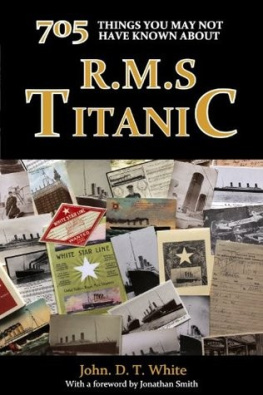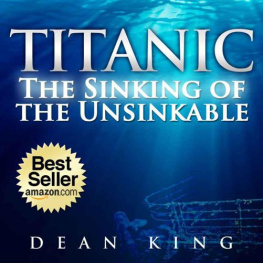Cape Race: stories from the coast that sank the Titanic / Robert C.
Parsons.
Includes index.
1. Shipwrecks--Newfoundland and Labrador--History. 2. Cape Race
(N. L.)--History. I. Title.
FC2170. S5P36232011 971.8 C2011-901844-6
2011 by Robert C. Parsons
ALL RIGHTS RESERVED. No part of the work covered by the copyright hereon may be reproduced or used in any form or by any meansgraphic, electronic or mechanicalwithout the written permission of the publisher. Any request for photocopying, recording, taping, or information storage and retrieval systems of any part of this book shall be directed to Access Copyright, The Canadian Copyright Licensing Agency, 1 Yonge Street, Suite 800, Toronto, ON M5E 1E5. This applies to classroom use as well.
FLANKER PRESS LTD.
ST. JOHNS, NL
Cape Race,
Calamity Coast
People on Canadas east coast, the maritime regions, have experienced the temperament of the North Atlantic Ocean: beautiful, moody, mysterious, violent, destructive, peaceful, bountiful. It would seem that the sea is vindictive: apt to give, then to snatch back, as if exacting a price for its bounty. The cold Atlantic has a capacity, with its tremendous force and power, to take human life seemingly at will; however, almost contradictorily it can spare a life and allow miraculous escapes.
From an early date in the timeline of Atlantic navigation, the area around Cape Race, the southeastern tip of the Avalon Peninsula, was recognized as being treacherous for navigation. The coastline one of many with the dubious name of Graveyard of the Atlantic stretches for the purpose of this overview from Clam Cove on the east, westward to Cape Freels.
Shipowners, navigators, captains, and sailors knew the area was often covered in thick fogs (averaging about 160-170 days a year). The seas around it were, and to some extent still are, frequented by icebergs. The land and seascapes around Cape Race are rugged, rife with offshore rocks and reefs. The London Illustrated News agrees, saying:
Cliffs rise precipitately out of the water, cracked and split asunder in many places by some great convulsion of nature. A huge black rock lifts its head up out of the deep water immediately in front of Cape Race. The eternal wash of the Atlantic has worn deep hollows, and in some cases masses of rock stand out isolated from the great granite wall that breaks the ever-restless ocean that thunders against it.
The tides sweeping around the corner are irregular, but often with an inset landward; that is, tending to pull ships toward the rocky coast as opposed to seaward. The navigators in the age of exploration were generally pleased in their selection of names for various headlands. But, by a unique use of language, often the true meanings of early names are confusing. The original name of Cape Race is Raso, a Portuguese word meaning at. It gives no indication of danger or the lack of it.
By the late 19th century, as the newspaper Evening Mercury (September 21, 1888) points out, Cape Race:
With its large block of buildings stands out clearly dened against the summer sky. Cape Race is, as its original name explained, a striking promontory, a bold headland, both a welcome and a warning to the mariner.
If one reads on in the same venerable newspaper, it can be seen a week later, in the September 29, 1888, edition, this brief piece:
Cape Race
Wind E. S. E., light, hazy, heavy sea; barquentine Minnie went west at 11 a.m.
Trepassey
The hull of the brig Anastatia was sold yesterday for 60 cents; her sails and running gear, yards, spars, etc. are to be sold this evening at three oclock...
The barquentine Minnie, as observed from the Cape Race lighthouse, had made it past the dangers. Brig Anastatia had run afoul of the rocks of Cape Race, was totally wrecked, and its hull and gear were sold at an auction. Despite the large block of buildings the lighthouse, keepers dwelling, and outbuildings the rugged coastline and tides claimed Anastatia as another victim. Fortunately there was no loss of life.
Despite all hazards, for 450 years Cape Race remained a fundamental and desired landmark in transatlantic shipping. It is located near the Great Circle, the route taken by sailing ships and steamers going to or from Europe to North America.
However, it was not until 1856 that the rst lighthouse was built at Cape Race. Commissioned and constructed by Englands Imperial Government, it began its distinction of a welcoming landfall and as a portent of danger. Still, up to 1863, for seven years it was just a lighthouse no foghorn or whistle.
It was a case of lead, kindly light; no alarm or warning sound (save that of the raging surf) of any kind existed at Cape Race. A foghorn had been proposed by the United States, which had lost several large liners in the treacherous area, but the proposition was ridiculed as a Yankee suggestion.
For a lengthy time in communication history, the cape was a focal point and link for mail and telegraph between the two continents.
According to the Encyclopedia of Newfoundland and Labrador, it was at Cape Race, in 1858, that the Associated Press of New York, after the failure of the rst transatlantic cable, stationed a news boat to meet the liners coming from England and to retrieve news copy dropped overboard in a canister.
The lighthouse was connected to the telegraph network and by this means news reached the mainland two or three days ahead of the ships. The practice of dropping news canisters may have contributed to the 1863 wreck of the Anglo Saxon, in which 237 people lost their lives. That ship may have kept too close to the land, with terrible results. When the rst transatlantic cable was landed in Newfoundland at Hearts Content in 1866, it eliminated the need for the ship canister drop-off.
Yet, the Anglo Saxon disaster again demonstrated the need for a foghorn. Although the light was converted from xed to revolving three years after the accident, it was several years before the needed steam whistle was installed.
In 1901 the fog alarm itself was inadvertently the cause of another wreck when the steamer Assyrian mistook it for the whistle of another vessel and ran aground. In 1907 the original whistle was replaced by an air-operated double diaphone alarm, and in 1963 a diesel-powered foghorn was installed.
Although Cape Race had a telegraph system for many years, in 1904 it became the site of a wireless station run by the Marconi Company. With a range of 300-400 miles, wireless could communicate with passing ships off shore using Morse code. As such it received and relayed many distress signals from ships in trouble on the Atlantic Ocean.


















